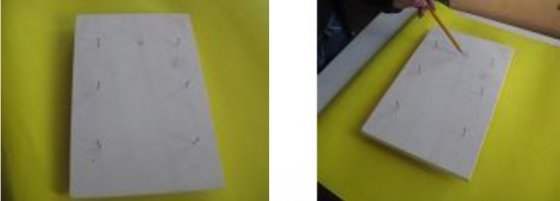Home page > Dejavnosti > Zvok

Marina di Carrara
Salt dance
There is no sound without vibration
Conclusions
A body that vibrates makes a sound and transmits its movement to the surrounding. The air moves away in all directions in the form of waves. When sound waves reach the film they make it vibrate and this moves the salt. Sound waves are not seen in the air but we can see their effects.
Hang in there
Experiment:
To investigate whether sound travels better through a solid or a gas.
Materials:
You will need-
Two 30 cm pieces of thread.
One metal clothes hanger.
A piece of paper and a pen to record your results.
Method:
What you have to do-
1) Tie one piece of thread to each end of the hanger.
2) Hold the hanger upside down by the ends of the pieces of string.
3) Bang the hanger against a table.
4) Listen to how loud the sound is!
5) Now repeat steps one and two but this time put your fingers in your ears while holding the strings.
6) Bang the hanger against a table.
7) Listen to how loud the sound is!
Results:
Did you discover what we did?
When your fingers are in your ears the sound is much louder.
Conclusions:
Sound travels better through a solid (string), than through a gas (air).
Sound without air?
IS THERE ANY SOUND WITHOUT AIR?
Hydrophone
Experiment:
To make a hydrophone and to examine whether or not sound waves can travel under water.
Materials:
You will need-
A plastic 2 litre bottle.
A basin. Water.
Two rocks.
A scissors.
A Friend.
Method:
What you have to do-
1) Cut off the base of the plastic bottle.
2) Fill the basin with water, but not to the top.
3) Place the plastic bottle into the water.
4) Put your ear to the top of the bottle.
5) Ask your friend to bang two stones together under the water, near the bottle.
6) Repeat the experiment above the water.
Results:
Did you discover what we did?
Can sound waves travel through water?
Through which does sound travel better, air or water?
Conclusions:
What did you discover?
Table thunder
Experiment:
Another experiment to investigate whether sound travels better through a solid or a gas.
Materials:
You will need
- One friend. One table.
A piece of paper and a pen to record your results.
Method:
What you have to do-
1) Sit opposite your friend.
2) Knock on the table.
3)Listen to how loud the sound is.
4) Ask your friend to place their ear against the surface of the table.
5)Knock on the table again.
6) Ask your friend to describe how loud the sound is through the table.
Results:
Did you discover what we did?
When you listen to the knocking sound through the table, it is much louder.
Conclusions:
Sound travels better through a solid (table), than through a gas (air).
Tension & sound
YOU WILL NEED:
1-A rod wood
2-Some corks
3-A string
4-Metal hooks
INSTRUCTIONS:
- Fix the corks to the rod wood
- Roll up the string around the first cork
- Slip the string in the metal hooks on the corks.
Pluck the string with your finger, without pressing on any of the corks.
1) Listen to the note
2) Roll more the string around the first cork
3) Pluck the string again..
4) Does it sound different again?
Vibrating wires
-Sound pitch and frequency of the wave-
What you need
Two wooden tablets
Nails and hammer
A ruler
Nylon threads ( for example fishing line) of varying thickness

What you have to do
FIRST PART
• Fix three pairs of nails so that the distance between each pair of nails is growing ( e g. 10cm, 15 cm e 20 cm).
•Stretch a wire between the nails of the same thickness of each pair so that it is pulled.
•Now pluck the strings and see how the pitch varies ( or if the sound is more or less acute).
SECOND PART
•Now fix other three pairs of nails on the other tablet, keeping the same distance between the nails of all the pairs.
•Connect the nails of each pair with different thickness wire, holding it in a uniform way.
•Still pluck the strings and see whether and how the pitch varies.
Reflections
Why, to test the influence of the length of the wire on the pitch, should the wire stretched between the nails be of the same thickness?
How does the pitch vary according to the length of the wire?
Why, to test the influence of the thickness of the wire on the pitch, should the wire stretched between the nails be of the same length?
How does the pitch vary changing the thickness of the wire?
What can you conclude?
Recalling that the sound is more acute when the wave frequency is greater, put in relation the frequency of the wave with the thickness of the wire.
Conclusions
In the two parts of the experience we analyze one variable at a time.
The pitch decreases with increasing length of the wires.
The pitch decreases with increasing thickness of the wire
The sound is more acute when the wire is shorter and thinner.
The wave frequency increases with decreasing thickness of the wire and it decreases as the length of the wire increases.














